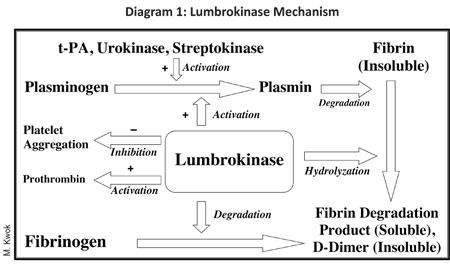|
Page 1, 2
Heart attack and stroke are the two most devastating and common circulatory issues we face in our time. Heart attacks are due to blockage of coronary arteries, and majority of stroke cases are due to thromboembolism. Currently there are three main categories of pharmaceutical agents used to treat or prevent ischemia issues: thrombolytics, antiplatelets, and anticoagulants. Thrombolytics can be a life-saver in acute situations when used appropriately but have a few drawbacks: short window of opportunity for its application, the risk of intra-cranial bleeding, and the fact that they have to be administered via intravenous infusion. Antiplatelets and anticoagulants may be used acutely or as a secondary prevention. They work by interfering with the coagulation system thus limiting the spread or worsening of the ischemia; they do not resolve the existing thrombus or embolus. It is still up to the body's own fibrinolytic system to resolve the blockage, which may or may not happen. Like thrombolytics, antiplatelets and anticoagulants also carry the risks of causing unforeseen bleeding in spite of due care or testing. Is there not a safer and also effective natural option for helping patients besides the above categories of pharmaceuticals? The answer is "YES," and the agent is called LUMBROKINASE!
 Townsend Letter provides a platform for those examining and reporting on functional and integrative medicine. Please support these independent voices. Townsend Letter provides a platform for those examining and reporting on functional and integrative medicine. Please support these independent voices. |
What Is Lumbrokinase?
Lumbrokinase is a complex enzyme preparation extracted from earthworms. Lumbrokinase can also be referred to as earthworm powder enzymes (EPE) or earthworm fibrinolytic enzymes (e-PPA). Earthworms have been used in traditional Eastern medicine for thousands of years in countries such as China, Japan, Korea, and others. According to the ancient Chinese medical publication Ben Cao Gang Mu (Compendium of Chinese Botanical and Animal Products), earthworms or "Earth Dragons" possess the properties to "invigorate blood, resolve stasis, and unblock the body's meridians and channels." As a result, earthworms are commonly included in traditional herbal formulae that treat ischemic or thromboembolic conditions.
Inspired by the empirical wisdom of traditional Eastern medicine, modern Japanese researchers started searching for active ingredients that could account for the observed properties of earthworms. Finally, in 1983 Dr. Hisashi Mihara succeeded in extracting powerful fibrin-dissolving enzymes from earthworms, and he named this group of enzymes lumbrokinase.1 Since then, Korean and Chinese researchers have compiled extensive in vitro, animal, and clinical data on the safety and potential applications of lumbrokinase over the past 30 years.
As of February 18, 2018, a simple PubMed keyword search of "lumbrokinase" generated 65 results, with papers dating as far back as 1991 and as recent as February 2018. However, performing the same keyword search in one of the largest Chinese digital periodicals database (www.cnki.net) generated over 650 publications! This article is by no means an attempt to summarize all of the available clinical research on lumbrokinase, but merely to point out some of the clinically relevant highlights. Still, what is presented here is barely scratching the surface.
 Mechanisms of Lumbrokinase Mechanisms of Lumbrokinase
Over the years various researchers have extracted lumbrokinase from different earthworm species by different methods and also studied its physiological properties in animal models. Most research indicated that lumbrokinase is primarily a fibrinolytic enzyme and it possesses both direct and indirect fibrinolytic effects.2,3 It can activate the innate plasminogen system and also can achieve direct fibrinolysis independent of the plasminogen system (see Diagram 1). In 2004, Zhang el al discovered that lumbrokinase also inhibits PAI-1 activity and enhances t-PA activity.4 In addition to being a strong fibrinolytic agent, lumbrokinase may indirectly achieve anticoagulation by inhibiting platelet functions. Jiang et al. were among the first researchers to report on such a property.5 Interestingly, many people are not aware that lumbrokinase contains an enzyme that has opposing actions on the coagulation system. In a paper published in 2007, Zhao et al. demonstrated that lumbrokinase not only promotes fibrinolysis but also prothrombin activation (thus fibrinogenesis).6 It appears that Nature has intended lumbrokinase to have a bi-directional rather than a uni-directional property. This built-in "balancing" mechanism may have contributed to the excellent safety record of lumbrokinase as explained later in the article.

Potential Clinical Applications
As an oral enzyme supplement, lumbrokinase is not allowed or approved to make any therapeutic claims in North America. However, by looking into available animal and human research, it is not too hard for anyone to see the following potential applications:
Ischemic Stroke. To further explore the traditional medical uses of earthworms in stroke, naturally one of the most intensely researched areas has been in the prevention and treatment of ischemic stroke patients. Lumbrokinase has been shown to be safe and effective for treating acute ischemic stroke by lowering blood viscosity, preventing re-perfusion damage, and reducing neural deficits.7-9 It was also shown to improve the efficacy of aspirin as a secondary prevention of stroke.10,11 In fact, for people who are resistant to aspirin (thus does not benefit from taking aspirin as a prevention), lumbrokinase appears to negate aspirin resistance and potentially help achieve the goal of cardiovascular disease prevention.12
Coronary Artery Disease. Lumbrokinase is equally impressive in the treatment of coronary arterial diseases, including patients with unstable angina. Besides lowering whole blood viscosity, plasma viscosity, fibrinogen, and ESR, research data indicated that lumbrokinase was able to minimize angina attack frequency, minimize the need for nitroglycerine, and improve ST segment elevation on the EKG.13-16 Other potential applications of lumbrokinase in circulatory conditions include deep venous thrombosis,17 essential hypertension,18 vascular dementia,19 etc.
Oncology. It is a well-known fact that most cancer patients (especially late stage) are hypercoagulable and prone to develop venous thromboembolism.20-22 Thus, it is quite reasonable to use lumbrokinase in the prevention or treatment of cancer-associated thromboembolism. In recent years lumbrokinase has also been investigated as a potential anti-tumor and anti-metastatic agent. There is various in vitro and clinical evidence pointing towards the involvement of hypercoagulation in stimulating tumor growth and metastasis.23,24 There are also evidence showing the potential use of anti-coagulants in limiting cancer growth and metastasis.25-27 Thus, it is quite reasonable to investigate if lumbrokinase can be beneficial in the overall treatment of oncology patients. Though still early in the research stage, lumbrokinase has been shown to inhibit stomach cancer cell growth and liver cancer cell metastasis in vitro and in animal models.28-30 Human studies are surely to follow in the near future.
Chronic Biofilm-Associated Infections. Biofilm-associated chronic infection has become a popular topic in recent years. Thus, it is worth mentioning that lumbrokinase has been shown to break down biofilm and improve the effectiveness of antibiotics in vitro, though it still lacks human studies at this point. However, since chronic infection and chronic inflammation tend to create a hypercoagulable blood state,31,32 some clinicians may feel that lumbrokinase's true benefit is in reducing hypercoagulation-associated complications.
Other note-worthy areas of lumbrokinase research: It may improve diabetic nephropathy33 and diabetic neuropathy.34 It may prevent the damage to heart cells from second-hand smoke.35 It may also play a role in promoting bone repair and regeneration.36,37
Page 1, 2
|
![]()
![]()
![]()
![]()







